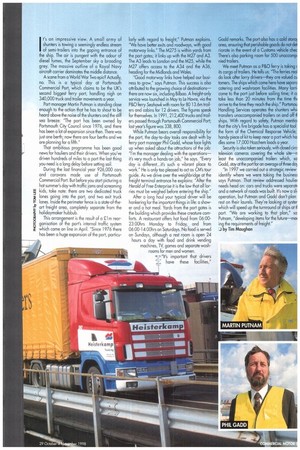LURE OF THE 41= 111= A delk
Page 52

Page 53

If you've noticed an error in this article please click here to report it so we can fix it.
Portsmouth is experie a boom in freight bu46 s Tim Maughan *ited the South Coast port to find out why its traffic has grown by a third in just six years.
It's an impressive view. A small army of shunters is towing a seemingly endless stream of semi-trailers into the gaping entrance of the ship. The air is pungent with the odour of diesel fumes, the September sky a brooding grey. The massive outline of a Royal Navy aircraft carrier dominates the middle distance.
A scene from a World War Two epic? Actually, no. This is a typical day at Portsmouth Commercial Port, which claims to be the UK's second biggest ferry port, handling nigh on 340,000 truck and trailer movements a year.
Port manager Martin Putman is standing close enough to the action that he has to shout to be heard above the noise of the shunters and the stiff sea breeze: "The port has been owned by Portsmouth City Council since 1976, and there has been a lot of expansion since then. There was just one berth; now there are four berths and we are planning for a fifth."
That ambitious programme has been good news for hauliers and their drivers. When you've driven hundreds of miles to a port the last thing you need is a long delay before setting sail. During the last financial year 926,000 cars and caravans made use of Portsmouth Commercial Port. But before you start picturing a hot summer's day with traffic jams and screaming kids, take note: there are two dedicated truck lanes going into the port, and two exit truck lanes. Inside the perimeter fence is a state-of-theart Freight area, completely separate from the holidaymaker hubbub.
This arrangement is the result of a Qlm reorganisation of the port's internal traffic system which came on line in April "Since 1976 there has been a huge expansion of the port, particu
larly with regard to freight," Putman explains "We have better exits and roadways, with good motorway links." The M275 is within yards from the port gates; it links up with the M27 and A3. The A3 leads to London and the M25, while the M27 offers access to the A34 and the A36, heading for the Midlands and Wales.
"Good motorway links have helped our business to grow," says Putman. This success is also attributed to the growing choice of destinations— there are now six, including Bilbao. A Freight-only service was launched in May to Le Havre, via the P&O ferry Seahawk with room for 80 13.6m trailers and cabins for 12 drivers. The figures speak for themselves. In 1991, 212,400 trucks and trailers passed through Portsmouth Commercial Port; last year's figure was 338, 800. While Putman bears overall responsibility far the part, the day-to-day tasks are dealt with by ferry when manager Phil Gadd, whose face lights up when asked about the attractions of the job: "I'm the manager dealing with the operations— it's very much a hands-on job," he says. "Every day is different...it's such a vibrant place to work." He is only too pleased to act as CM's tour guide. As we drive over the weighbridge at the freight terminal entrance he explains: "After the Herold of Free Enterprise it is the law that all lorries must be weighed before entering the ship." After a long haul your typical driver will be hankering for the important things in life: a shower and a hot meal. Yards from the port gates is the building which provides these creature comforts. A restaurant offers hot food from 06:0023:00hrs Monday to Friday, and from 06:00-14:00hrs on Saturdays. No food is served on Sundays, although a rest room is open 24
hours a day with food and drink vending machines, TV, games and separate washrooms for men and women.
– "It's important that drivers _
have these facilities," Gadd remarks, The port also has a cold storai area, ensuring that perishable goods do not det riorate in the event of a Customs vehicle chec There's also parking room for 500 unaccomp nied trailers.
We meet Putman as a P&G ferry is taking c its cargo of trailers, He tells us: 'The ferries real do look after lorry drivers—they are valued cu
tamers. The ships which come here have separa catering and washroom facilities. Many lorri. come to the port just before sailing time; it cc take less than 20 minutes from the time th( arrive to the time they reach the ship." Portsmou Handling Services operates the shunters wh transfers unaccompanied trailers on and off if ships. With regard to safety, Putman mentioi that the city's fire brigade has a specialist tool the form of the Chemical Response Vehicle; handy piece of kit to keep near a port which ha dies some 17,000 Hazchem loads a year.
Security is also taken seriously, with closed ciro televsion cameras covering the whole site—n least the unaccompanied trailers which, so Gadd, stay at the port for an crverage of three da) "In 1997 we carried out a strategic review identify where we were taking the business
says Putman. That review addressed haulier needs head on: cars and trucks were separati and a network of roads was built. It's now a sli.
operation, but Putman and Gadd don't plan
rest on their laurels. They're looking at syster which will speed up the turnround of ships at ti port. "We are working to that plan," so Putnam, "developing items for the future—met ing the requirements of freight."
_I by Tim Maughan
















































































































